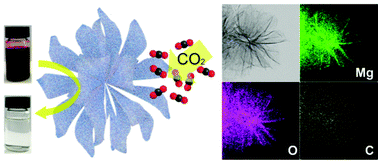Construction of a hierarchical-structured MgO-carbon nanocomposite from a metal–organic complex for efficient CO2 capture and organic pollutant removal†
Abstract
Rational engineering of the architecture and structure of an adsorbent material is essential for high-performance adsorption. Herein, a porous nanocomposite composed of MgO and carbon species (MgO/C) with a hierarchical architecture is fabricated via the simple pyrolysis of a Mg-containing metal–organic complex. Our investigations reveal that with the unique architectural and chemical characteristics, MgO/C performs as a remarkable solid adsorbent for gas adsorption and wastewater treatment. Impressively, in CO2 uptake, it exhibits exceptionally high CO2 capture capacity, a fast sorption rate and excellent stability. Additionally, the MgO/C nanocomposite is capable of displaying extraordinary adsorption properties in the removal of Congo red (CR) from water. The maximum CR uptake capacity can even reach as high as 2937.8 mg g−1, which is the highest recorded value among all of the previously reported solid adsorbents. The work presented here is expected to give fresh inspiration for the refined design of next-generation advanced solid adsorbents for environmental remediation including CO2 abatement and water purification.



 Please wait while we load your content...
Please wait while we load your content...